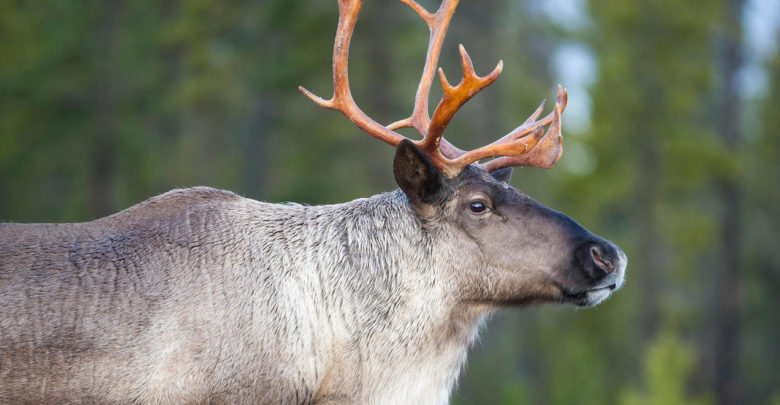 Alamy Stock Photo
Alamy Stock Photo Jasper Park is facing an irreversible change to the wildlife populating it.
The Maligne caribou herd are officially extirpated — meaning locally extinct — according to an update made to Parks Canada’s website early in September. Two other caribou herds residing within the park are dangerously close to following suit.
According to Brenda Parlee, a professor in the department of resource economics and environmental sociology at the University of Alberta, little effort was made by the Canadian government to protect the Maligne herd, despite the population having been identified as at risk in 2002.
“It’s a tragedy,” she said. “We’ve had so long to address the problem but didn’t.”
Opportunities for intervention missed
Parlee mentioned climate change, the effect of settlements and roads on migration patterns, and changes of predator prey dynamics are some of the factors that have led to the extinction.
“There’s a spectrum of possible kinds of interventions that could have been made,” Parlee said. “We didn’t press stop on a lot of the losses of habitat, the impacts of development, fragmentation from forestry. Between 2002 and 2020 these things actually increased substantially.”
Parlee highlighted the disparity between biodiversity on lands managed by settlers versus those managed by indigenous populations. She cited one example of West Moberly First Nation in British Columbia leading a caribou conservation initiative.
“They’ve essentially found those last remaining caribou to try and protect them from these extreme situations of vulnerability,” she said. “They’ve fenced off an area to encourage reproduction and limit predation. That’s a more comprehensive and hands on intervention that could have been made.”
Government consultation “just talk,” says director of livelihood for Treaty 8
Kevin Ahkhimnachie, the director of livelihood at Treaty 8 — a position that entails overseeing matters relating to environment and land — spoke about how he hasn’t seen much result from numerous consultations with the federal and provincial government.
“It’s basically a slideshow, feel good type of thing,” he said. “Then [the government] ticks off the box like ‘there were 18 first nations people that were present, their names are here, they were consulted,’ then, ‘see ya!’”
Ahkhimnachie described how some government initiatives use online surveys to gain First Nations input, ignoring the fact that elders sometimes live in places where there is no internet connection.
Additionally, he emphasized how Treaty 8 expertise is often overlooked during important conversations.
“A few years ago we were at the Alberta Caribou Committee and government administrators were screaming at each other saying a herd in northwest Alberta was gone,” he said. “A little elder raised his hand in the back and said ‘did you guys know [the herd] has a migration pattern? Next year it’ll be in British Columbia and the Northwest Territories, and then it’ll come back.’ Little things like that happen all the time. Traditional knowledge or just common sense isn’t there.”
He described the caribou as holding a lot of spiritual importance for many people of Treaty 8.
“[The caribou are] majestic, they’re awesome, but yeah, something has to be done about [extirpation]. A lot of people talk about it and talk about it, we have forums and we fly somewhere and have fancy coffee and that’s it, it’s just talk right? There needs to be some sort of action,” he said.
Ahkhimnachie described how Treaty 8 has a long term goal of transitioning from a non-governmental organization (NGO) to a political one, and that this shift will extend to how they address the ongoing extirpation.
“We’re looking at probably just coming up with our own caribou plan, our own policy, our own framework,” he said.
Caribou extirpation “not random,” said Parlee
Ahkhimnachie noted that while caribou has garnered a lot of media attention at the moment, other populations are at risk for similar reasons.
“There’s concern about caribou, but nobody’s really looking at moose populations or elk or deer,” he said.
Parlee also emphasized how the Maligne herd’s extirpation in Jasper Park is connected to the effect governmental decisions have on the current climate crisis.
“It’s not something that’s kind of random or a natural occurrence,” she said. “The sociopolitical context in which we’re living is an important consideration. It’s the decisions we’ve made in Alberta, in Canada, to privilege specific kinds of values and uses of land that has led to this outcome.”
Despite the efforts of those fighting for conservation, Parlee said that for people living in urban areas, the news might only feel quaint.
“The idea that we’ve lost this herd of caribou may seem like something that we’ve watched in a movie or like a disney issue,” she explained.
“it’s something frivolous that we go ‘oh that’s too bad, but nothing we can do, we’ve got more important economic issues to deal with,’ like human health issues. But these issues are all interrelated. Challenges and stresses on ecosystems translate into challenges and stresses for economy and health.”




